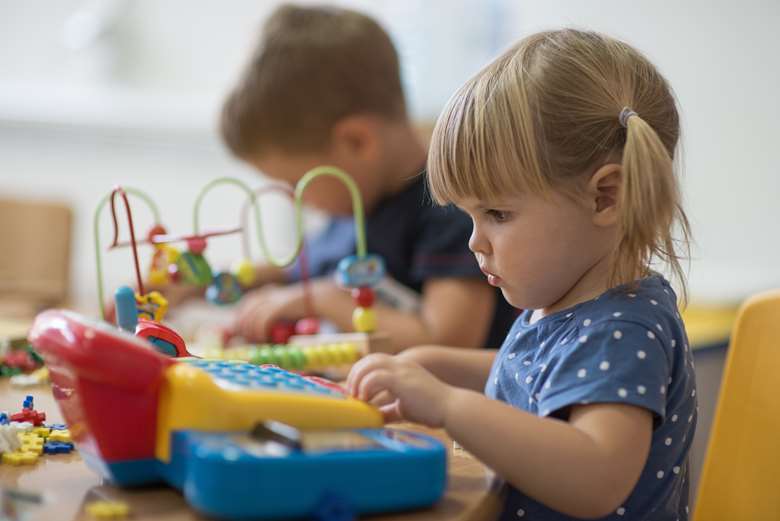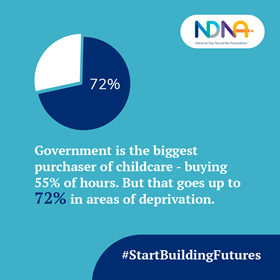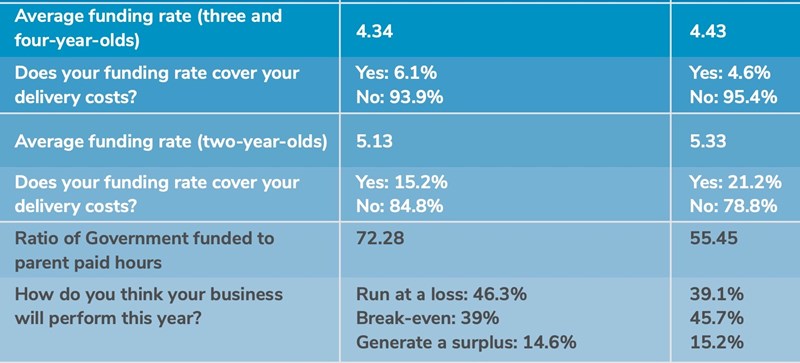Sharp rise in number of nurseries making a loss – survey
Catherine Gaunt
Thursday, September 9, 2021
More than eight in ten private, voluntary or independent nurseries in England are making a loss or only just breaking even, according to a survey by the National Day Nurseries Association.

The average nursery has lost more than £26,000 in the last year due to the impact of the pandemic, according to responses from more than 1,200 providers, from single-site settings to large nursery groups.
The Stop Underfunding – Start Building Futures survey found that 85 per cent will make a loss or just break even – this compares to 54 per cent of providers who said this in 2018.
Across all areas of England, 39 per cent of providers will run at a loss this year, according to the findings.
The annual shortfall for every child funded on a 30 hours place is £2,132.
The NDNA finances survey received 406 responses from providers across 1,251 nursery settings.
NDNA said the research highlights the precarious situation for childcare providers, as years of underfunding, combined with the pandemic have left many in an unsustainable position.
Just one in six providers expect to make a surplus, which is essential for investing in their staff and facilities.
The survey also reveals that around half of providers have not received the full 6p increase to their funding this year, with more than a quarter receiving no rise at all in their funding rates.
Ninety-five per cent of the childcare providers that responded to the survey say that Government funding for three-and four-year-olds does not cover their costs.
The report also highlights that the Government buys the most hours through funded places.
Parental patterns of employment have changed during the pandemic, it points out, impacting the demand for childcare places and hours.
NDNA asked providers to provide a breakdown and found that 55 per cent of hours were Government-funded and 45 per cent were paid for by parents.
'The Government is the largest purchaser of early education and childcare from providers, and this share is growing according to this survey,' the report said. 'Any underfunding of these places will have a greater impact on the sustainability of nurseries and the viability of children’s places.'

Impact on parents
Nurseries reported increasing their fees to cope with losses, with 41 per cent putting their fees up by more than 2 per cent, i.e above the rate of inflation.
Financial instability is also leading to nurseries limiting the number of funded places they can offer to parents (14 per cent of respondents), including for children with Special Educational Needs and Disabilities (SEND) because of the higher costs needed to support children (also 14 per cent).
Financial measures providers have taken in the last 12 months:
-
41 per cent said they had to raise fees for non- Government funded hours by over 2 per cent
-
34 per cent had taken out Government-backed Covid-19 loans
-
23 per cent said they had needed to increase the charges for consumables like meals, snacks and nappies, which sit alongside the funded childcare places
-
Other measures included limiting the number of funded places available, not being able to support children with additional needs and taking out commercial loans.
Covid losses
The survey also looked at the impact of lost income on settings as a result of temporary closures as well as staff and children being absent due to Covid-19. NDNA asked providers about lost income due to deferred, refunded or lost fees in the 12 months between June 2020 and July 2021 and received 187 responses.
The estimated total loss was £12.57 million. This was across 480 individual sites, suggesting an average loss of £26,179 per nursery. NDNA said the figures could be much higher as some respondents provided lost income as a percentage or were not able to accurately estimate losses they had experienced in this period.
Areas of deprivation
Settings in areas of deprivation are more likely to close than those in other parts of the country, NDNA research shows.
Analysing responses from settings that are based in the 20 per cent most deprived areas in England, they found that providers in the most deprived areas received lower rates on average than those in the rest of the country (see table below).
QUESTION 20 PER CENT MOST DEPRIVED AREAS ALL AREAS

Source: NDNA
‘While a similar proportion of those in areas of deprivation believed that the three and four-year-old rate does not cover their costs, they were more likely to say that the rate for two-year-olds is insufficient than the national picture,’ the report said. ‘This is crucial, as they are more likely to have children eligible for these places in their settings.’
This survey also showed that providers in areas of deprivation are more reliant on Government funding as a source of income and are more likely to be operating at a loss. These settings are more at risk of closure leading to a loss of places for children who have the most to gain from access to high quality early education and care, the report said.
Case study
Monkton Nursery School in Liverpool
Owner Dr Susan Poole said, ‘After being a successful nursery setting for the past 40 years, the last 18 months has changed my confidence in the financial security of my business. The huge losses in fees for the months when we could only accept Keyworker children, and the enforced closure of “bubbles” has put my 80-place setting in great financial difficulty. In practical terms too, it is a challenge to staff the rooms when practitioners test positive as there is a dramatic shortage of supply staff to replace staff at short notice.
‘It is impossible to build and maintain high standards in Nursery Education and Care without sufficient funding to pay experienced, professional well-qualified teachers and practitioners, and sadly the National Education Funding supplied by the Government falls way short of this level. In my own setting, we offer a minimum salary of £10 per hour upward, and maintain a loyal dedicated team who provide consistent support to our children, with many who have worked together for 10, 20 years and more. It is through these professionals that our children will learn and grow their confidence, but if the government does not recognise the cost of this by increasing the NEF to realistic levels, it is our young children who will suffer. There should at least be parity with the funding rates attributed to mainstream nursery schools.’
Responding to the survey, Tulip Siddiq MP, Labour’s shadow minister for children and early years, said, ‘This survey lays bare the dire financial situation that nurseries and other early years providers are in after a decade of Conservative underfunding.
‘We have already lost nearly 3,000 childcare providers since the start of the year. Without better support from government many more nursery and childminding businesses could collapse, which would leave thousands of families without the early education and childcare they need.
‘Labour’s Children’s Recovery Plan would deliver investment in early learning and set our youngest children on the road to recovery from the pandemic.’
A Department for Education spokesperson said, ‘We recognise that the pandemic has created challenges for early years providers, which is why we provided significant financial and business support throughout to protect them. The number of childcare places available to parents remains stable, and the majority of eligible two, three and four-year-olds have continued to access free childcare places despite these challenges.
‘We have invested more than £3.5 billion in childcare in each of the last three years, and we’re making millions more available through our early years recovery work to level up children’s outcomes.’
Key findings:
- The average funding rate paid to providers for three and four-year-old places is £4.43
- The average shortfall for each child per hour is £1.87 or £2,132 per child a year
- 56 per cent of nurseries have received the full 6p increase this year; 16.8 per cent received lower than 6p but 28 per cen have had no increase at all in April 2021
- The average funding rate paid to providers to deliver eligible two-year-old places is £5.33, with the average shortfall of £1.57
- In the average nursery an average of 55 per cent of children are Government-funded; parent-paid hours make up 45 per cent of children
- Due to the funding rate shortfall, 41 per cent have had to increase charges to parents by more than inflation (2 per cent) and 23 per cent have increased charges to parents for consumables (e.g. meals)
- 34 per cent have taken out a Government-backed Covid-19 loan
- Reintroducing business rates would see the average nursery hit with a bill of £12,640.58
- Across nurseries, they have an average of 8.6 per cent increase to their staffing budget.
Download the report
Download Now



